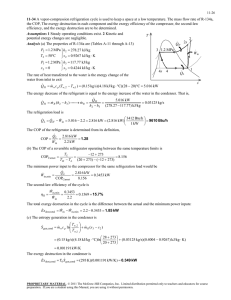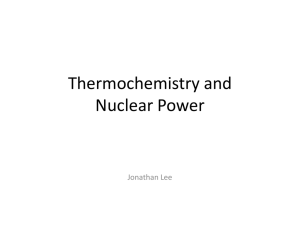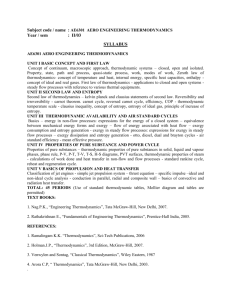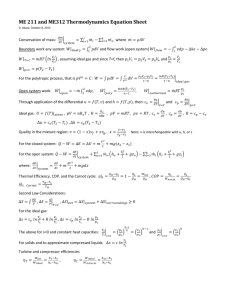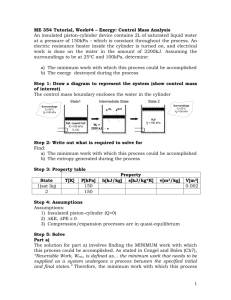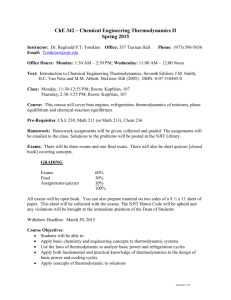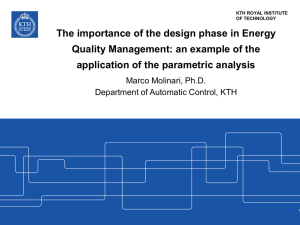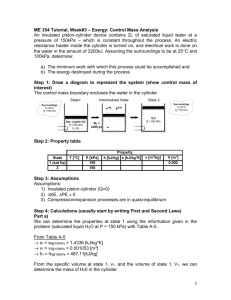Fundamentals of Engineering Thermodynamics
advertisement
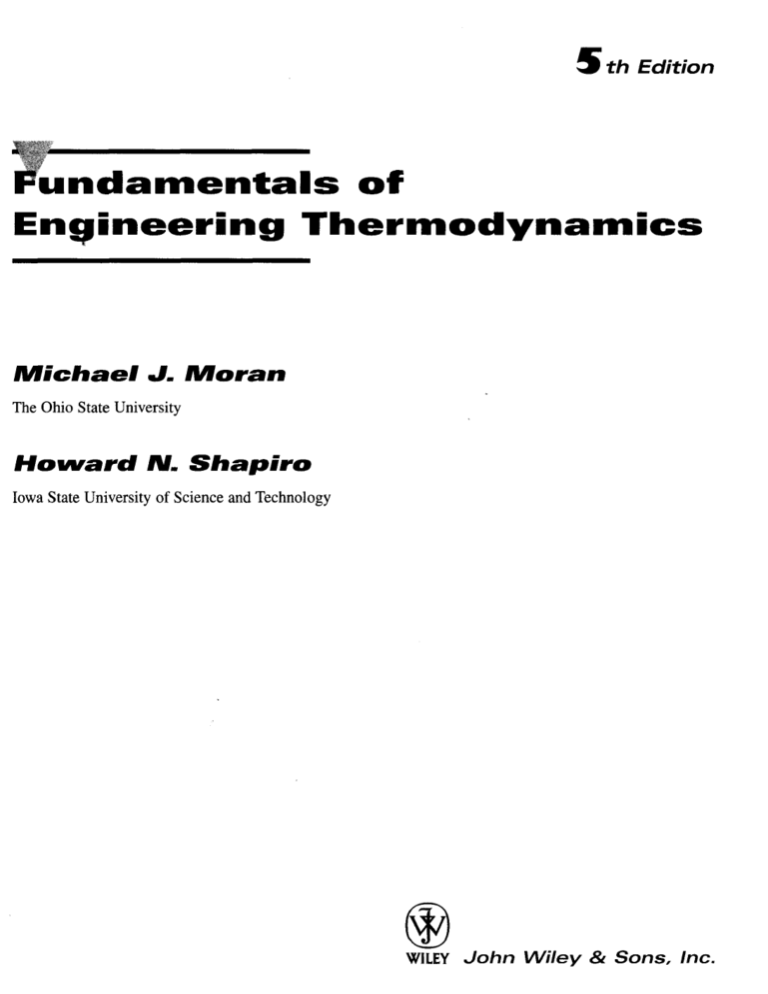
th Edition Fundamentals of Engineering Thermodynamics Michael J. H/loran The Ohio State University Howard Al. Shapiro Iowa State University of Science and Technology WILEY John Wiley & Sons, Inc. Contents CHAPTER I CHAPTER Getting Started: Introductory Concepts and Definitions 1 Control Volume Analysis Using Energy 131 . I Using Thermodynamics 1 .2 Defining Systems 1 .3 Describing Systems and Their Behavior 4 .4 Measuring Mass, Length,Time, and Force 8 .5 Two Measurable Properties: Specific Volume and Pressure 11 .6 Measuring Temperature 15 .7 Engineering Design and Analysis 20 Chapter Summary and Study Guide 24 4.1 Conservation of Mass for a Control Volume 131 4.2 Conservation of Energy for a Control Volume 138 4.3 Analyzing Control Volumes at Steady State 141 4.4 Transient Analysis 162 Chapter Summary and Study Guide 172 CHAPTER 2 CHAPTER Energy and the First Law of Thermodynamics 32 The Second Law of Thermodynamics 187 2.1 Reviewing Mechanical Concepts of Energy 32 2.2 Broading Our Understanding of Work 36 2.3 Broading Our Understanding of Energy 46 2.4 Energy Transfer By Heat 47 2.5 Energy Accounting: Energy Balance for Closed Systems 51 2.6 Energy Analysis of Cycles 61 Chapter Summary and Study Guide 65 5.1 Introducing the Second Law 187 5.2 Identifying Irreversibilities 193 5.3 Applying the Second Law toThermodynamic Cycles 197 5.4 Defining the Kelvin Temperature Scale 203 5.5 Maximum Performance Measures for Cycles Operating Between Two Reservoirs 205 5.6 Carnot Cycle 210 Chapter Summary and Study Guide 212 CHAPTER 3 Evaluating Properties 75 3.1 Fixing the State 75 EVALUATING PROPERTIES: GENERAL CONSIDERATIONS 76 3.2 p-v-T Relation 76 3.3 Retrieving Thermodynamic Properties 82 3.4 Generalized Compressibility Chart 101 EVALUATING PROPERTIES USING THE IDEAL GAS MODEL 107 3.5 Ideal Gas Model 107 3.6 Internal Energy, Enthalpy, and Specific Heats of Ideal Gases 110 3.7 Evaluating At/ and Ah using Ideal Gas Tables, Software, and Constant Specific Heats 112 3.8 Polytropic Process of an Ideal Gas 119 Chapter Summary and Study Guide 121 CHAPTER V Using Entropy 221 6.1 Introducing Entropy 221 6.2 Defining Entropy Change 223 6.3 Retrieving Entropy Data 224 6.4 Entropy Change in Internally Reversible Processes 232 6.5 Entropy Balance for Closed Systems 235 6.6 Entropy Rate Balance for Control Volumes 246 6.7 Isentropic Processes 255 6.8 Isentropic Efficiencies of Turbines, Nozzles, Compressors, and Pumps 261 6.9 Heat Transfer and Work in Internally Reversible, Steady-State Flow Processes 269 Chapter Summary and Study Guide 272 x Contents CHAPTER Exergy Analysis 291 7.1 Introducing Exergy 291 7.2 Defining Exergy 292 7.3 Closed System Exergy Balance 302 7.4 Flow Exergy 309 7.5 Exergy Rate Balapce for Control Volumes 312 7.6 Exergetic (Second Law) Efficiency 322 7.7 Thermoeconomics 328 Chapter Summary and Study Guide 334 CHAPTER 8 Vapor Power Systems 347 8.1 Modeling Vapor Power Systems 347 8.2 Analyzing Vapor Power Systems—Rankline Cycle 349 8.3 Improving Performance—Superheat and Reheat 362 8.4 Improving Performance—Regenerative Vapor Power Cycle 368 8.5 Other Vapor Cycle Aspects 378 8.6 Case Study: Exergy Accounting of a Vapor Power Plant 380 Chapter Summary and Study Guide 387 CHAPTER W Gas Power Systems 398 INTERNAL COMBUSTION ENGINES 398 9.1 Introducing Engine Terminology 398 9.2 Air-Standard Otto Cycle 400 9.3 Air-Standard Diesel Cycle 406 9.4 Air-Standard Dual Cycle 410 GAS TURBINE POWER PLANTS 413 9.5 Modeling Gas Turbine Power Plants 413 9.6 Air-Standard Brayton Cycle 414 9.7 Regenerative Gas Turbines 424 9.8 Regenerative Gas Turbines with Reheat and Intercooling 429 9.9 Gas Turbines for Aircraft Propulsion 439 9.10 Combined Gas Turbine—Vapor Power Cycle 444 9.1 I Ericsson and Stirling Cycles 449 COMPRESSIBLE FLOWTHROUGH NOZZLES AND DIFFUSERS 451 9.12 Compressible Flow Preliminaries 451 9.13 Analyzing One-Dimensional Steady Flow in Nozzles and Diffusers 455 9.14 Flow in Nozzles and Diffusers of Ideal Gases with Constant Specific Heats 461 Chapter Summary and Study Guide 469 CHAPTER 10 Refrigeration Systems 483 and Heat Pump IO. I Vapor Refrigeration Systems 483 10.2 Analyzing Vapor-Compression Refrigeration Systems 486 10.3 Refrigerant Properties 494 10.4 Cascade and Multistage Vapor-Compression Systems 496 10.5 Absorption Refrigeration 498 10.6 Heat Pump Systems 500 10.7 Gas Refrigeration Systems 502 Chapter Summary and Study Guide 508 CHAPTER II Thermodynamic Relations 518 I I.I Using Equations of State 518 I 1.2 Important Mathematical Relations 525 I 1.3 Developing Property Relations 528 I 1.4 Evaluating Changes in Entropy, Internal Energy, and Enthalpy 535 I 1.5 OtherThermodynamic Relations 544 I 1.6 Constructing Tables of Thermodynamic Properties 551 11.7 Generalized Charts for Enthalpy and Entropy 555 I 1.8 p-v-T Relations for Gas Mixtures 562 I 1.9 Analyzing Multicomponent Systems 567 Chapter Summary and Study Guide 579 CHAPTER 12 Ideal Gas Mixture and Psychrometric Applications 590 IDEAL GAS MIXTURES: GENERAL CONSIDERATIONS 590 12.1 Describing Mixture Composition 590 12.2 Relating p, V, and 7"for Ideal Gas Mixtures 594 Contents xi 12.3 Evaluating U, H, S and Specific Heats 596 12.4 Analyzing Systems Involving Mixtures 598 PSYCHROMETRIC APPLICATIONS 611 12.5 Introducing Psychrometric Principles 611 12.6 Psychrometers: Measuring the Wet-Bulb and Dry-Bulb Temperatures 622 12.7 Psychrometric Charts 624 12.8 Analyzing Air-Conditioning Processes 625 12.9 Coolifig Towers 641 Chapter Summary and Study Guide 643 CHAPTER 13 Reacting Mixtures Combustion 656 and CHAPTER 14 Chemical and Phase Equilibrium 718 EQUILIBRIUM FUNDAMENTALS 718 14.1 Introducing Equilibrium Criteria 718 CHEMICAL EQUILIBRIUM 723 14.2 Equation of Reaction Equilibrium 723 14.3 Calculating Equilibrium Compositions 725 14.4 Further Examples of the Use of the Equilibrium Constant 734 PHASE EQUILIBRIUM 743 14.5 Equilibrium BetweenTwo Phases of a Pure Substance 744 14.6 Equilibrium of Multicomponent, Multiphase Systems 745 Chapter Summary and Study Guide 750 COMBUSTION FUNDAMENTALS 656 13.1 Introducing Combustion 656 13.2 Conservation of Energy—Reacting Systems 665 13.3 Determining the Adiabatic Flame Temperature 677 13.4 Fuel Cells 681 13.5 Absolute Entropy and theThird Law of Thermodynamics 684 APPENDIX CHEMICAL EXERGY 691 13.6 Introducing Chemical Exergy 691 13.7 Standard Chemical Exergy 695 13.8 Exergy Summary 700 13.9 Exergetic (Second Law) Efficiencies of Reacting Systems 703 Chapter Summary and Study Guide 705 Answers to Selected Problems 865 Appendix Tables, Figures, and Charts 758 Index to Tables in SI Units 758 Index to Tables in English Units 806 Index to Figures and Charts 854 Index 869
